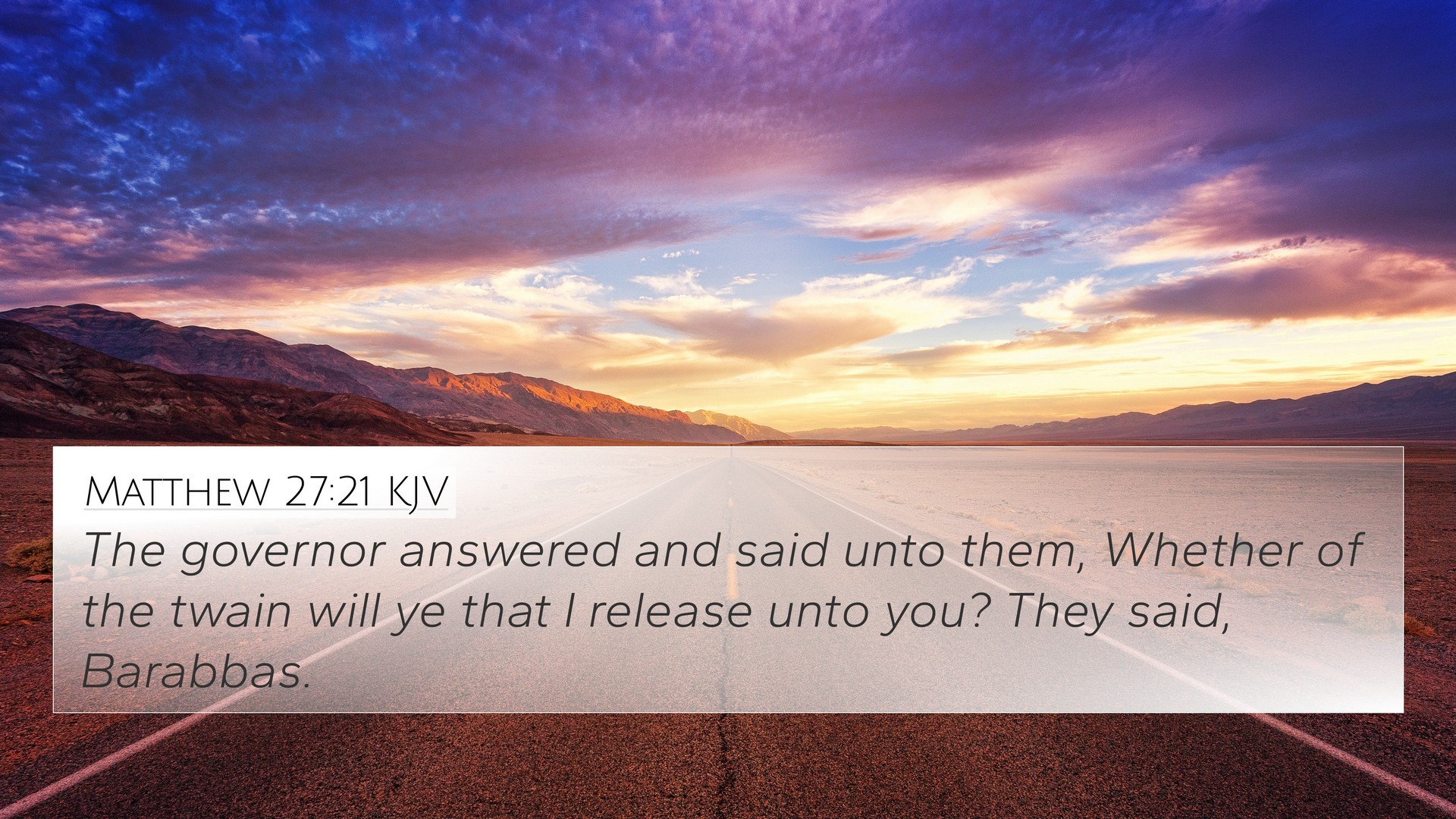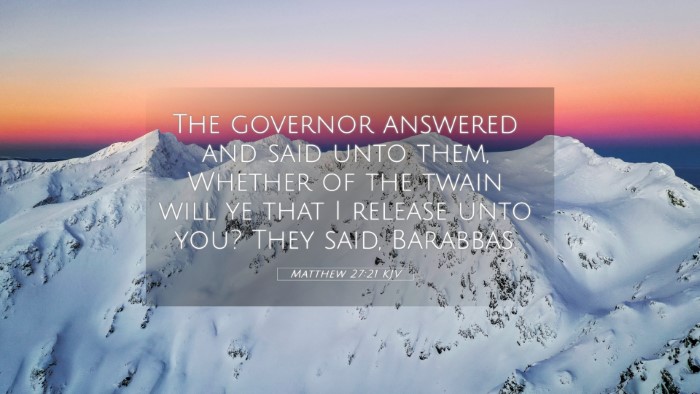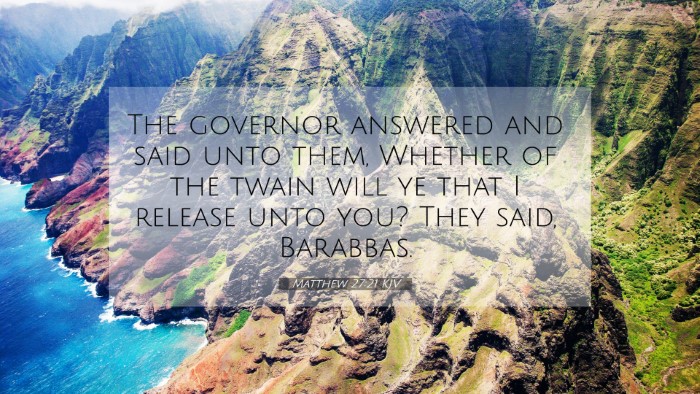Understanding Matthew 27:21
Verse Overview: Matthew 27:21 reads: "The governor answered and said to them, 'Which of the two do you want me to release to you?' They said, 'Barabbas!'" This verse captures a pivotal moment during the trial of Jesus before Pontius Pilate, where the crowd is given a choice to release either Jesus or Barabbas, a notorious criminal.
Interpretation of the Verse
Matthew Henry Commentary: Matthew Henry explains this scene as a representation of the stark contrast between good and evil. The choice presented to the people reflects the tendency of humanity to choose sin over righteousness. The decision to release Barabbas over Jesus symbolizes the rejection of the Savior by the very people He came to save.
Albert Barnes Commentary: Barnes emphasizes the significance of Barabbas' release and draws attention to the political and social dynamics of the crowd. He notes that the release of Barabbas, despite his crimes, highlights the public's rebellion against the notion of justice as represented by Jesus, who was innocent and undeserving of punishment.
Adam Clarke Commentary: Adam Clarke provides insights into the historical context of Barabbas's release. He discusses the custom of releasing a prisoner during the Passover and how this tradition was twisted by the chief priests to serve their purpose, emphasizing their manipulation of the political environment to provoke the crowd against Jesus.
Key Themes
- Human Choice: The choice presented to the crowd represents the choices individuals must make in life between good and evil.
- Rejection of Christ: This moment illustrates the tragic rejection of Jesus by those who should have recognized Him as the Messiah.
- Manipulation and Deceit: The actions of the religious leaders reflect the use of manipulation to achieve their own ends, showing the moral decay of leadership.
- Fulfillment of Prophecy: The choice of Barabbas aligns with Old Testament prophecies regarding the Messiah's rejection.
Cross-References
Matthew 27:21 relates to several other scripture passages, providing depth and connection to the larger narrative:
- Acts 3:14-15: This passage discusses the choice of the people in rejecting the Holy One, paralleling the rejection of Jesus.
- John 18:40: Here, the crowd shouts for Barabbas to be released, reinforcing the connection to Matthew 27:21.
- Luke 23:18-19: This account also depicts the choice between Barabbas and Jesus, highlighting the public's response.
- Mark 15:7: Similar to Matthew, Mark describes Barabbas as a notorious prisoner, showcasing the severity of the crowd’s decision.
- Isaiah 53:3: A prophetic reference to Christ being despised and rejected, setting the stage for understanding the crowd's choice.
- Matthew 21:42: Jesus speaks of the stone the builders rejected, connecting to the rejection theme seen in Matthew 27:21.
- John 1:11: This verse states that He came to His own, yet His own did not receive Him, echoing the sentiments of rejection found in Matthew 27:21.
- Romans 1:22-28: Discusses the folly of choosing unrighteousness, reminiscent of the crowd's choice of Barabbas.
- 1 Peter 2:4: Refers to Jesus as the living stone rejected by men, correlating with the rejection expressed in this event.
- Job 24:1: Job explains why the righteous suffer, connecting to the perceived injustice in Jesus' trial and eventual rejection.
Applying the Verse Today
The choice faced by the crowd symbolizes similar choices encountered in life today. Each individual is continually confronted with decisions that reflect their values and allegiances.
As we reflect on Matthew 27:21, we are urged to consider our own choices: do we select what is right and just, or do we, like the crowd, sometimes opt for what is popular or convenient? This calls us to explore Bible verse cross-references that help us understand our own lives in light of the Gospel.
Tools for Study
For those interested in deeper study, various Bible reference resources and tools for Bible cross-referencing can enhance your understanding:
- Bible Concordance: Identify where specific words are used across scriptures.
- Cross-Reference Bible Study: Engage in comparative studies of linked verses for deeper insight.
- Bible Cross-Reference Guide: Use guides that map out connections between Biblical texts.
- Comprehensive Bible Cross-Reference Materials: Access extensive resources that detail inter-Biblical dialogue.
- How to Find Cross-References in the Bible: Learn methods for locating related verses.
Conclusion
Matthew 27:21 serves as a profound reminder of the human condition and the choices we make, reflecting our values and ultimately our relationship with Christ. By utilizing tools for cross-referencing and studying the connections between Bible verses, we gain a richer understanding of our faith and its implications in our lives. Let this exploration encourage us to make choices that align with righteousness and truth, continuously deepening our understanding of the scriptures.


